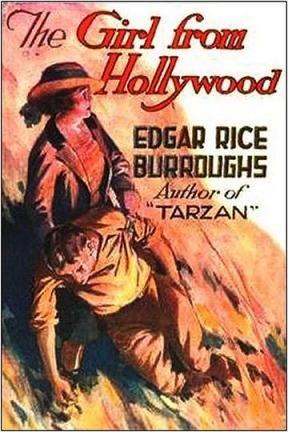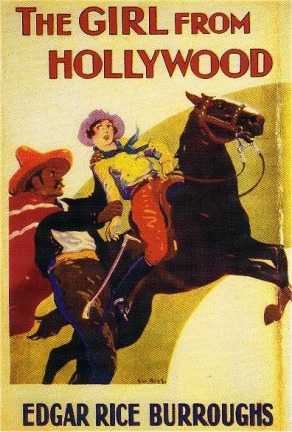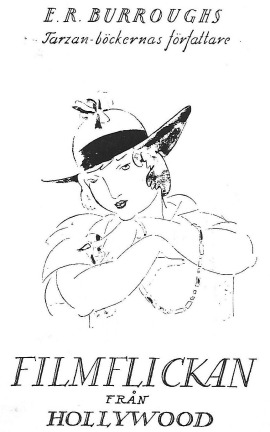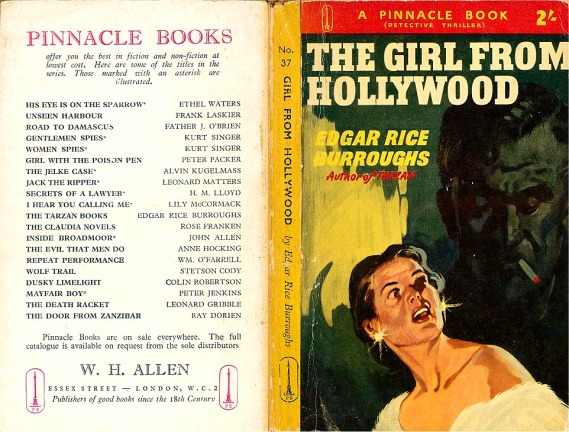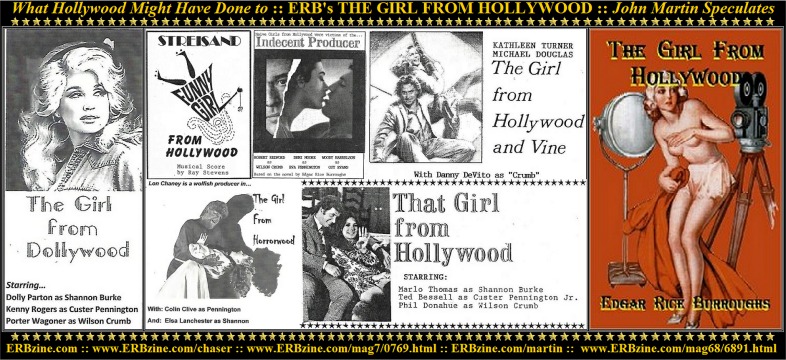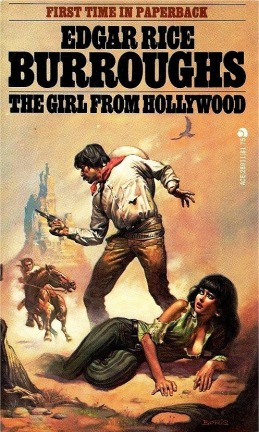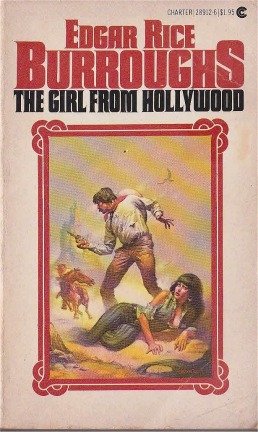Horses were a primary mode of transportation on ERB’s Tarzana Ranch as well as on Rancho del Ganado, the fictional spread which was the setting for ERB’s 1922 novel, “The Girl from Hollywood.” In ERB’s book, the Pennington family members were early risers: 
Official Edgar Rice Burroughs Tribute and Weekly Webzine Site
Since 1996 ~ Over 15,000 Webpages in Archive
Volume 6892
FAMILY TIES:
"THE GIRL FROM HOLLYWOOD"
IN ERB'S HOUSE: Part II
By John Martin
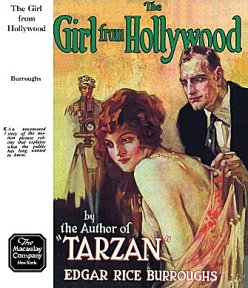
"THE GIRL FROM HOLLYWOOD" IN ERB’S HOUSE
Horses, of Course, on Tarzana Ranch -- 5/8“At a quarter before six she [Shannon Burke] was awakened by a knock on her door….” (GH, Chapter XIV) “The colonel and Mrs. Pennington were already mounted. Custer and a stableman held two horses, while the fifth was tied to a ring in the stable wall. It was a pretty picture—the pawing horses, with arched necks, eager to be away; the happy, laughing people in their picturesque and unconventional riding clothes; the new day upon the nearer hills; the haze upon the farther mountains.”
Does this, too, describe a typical real-life scene at the Tarzana ranch? Irwin Porges writes in “Edgar Rice Burroughs: The Man Who Created Tarzan,” “The ranch also provided the opportunity for Ed to return to horseback riding—an activity he had loved ever since his school days in Chicago and at Michigan Military Academy. Ed’s love of horses and enthusiasm for riding had been passed on to his family. By the following year, riding had become an important part of the family life. The children had their own saddle ponies, and even Emma had taken up the sport.” (Porges, 309-310)
ERB’s love for and familiarity with horses, gained not only from the military academy but also from his days as an Idaho cowboy and from his service with the 7th Cavalry in Arizona, is evident throughout the book.
ERB doesn’t merely use horses as props for the characters in his story, but he tells of little things which one unfamiliar with horses would not even know. For instance, in Chapter I we read, “The big bay stallion in the lead sidled mincingly, tossing his head nervously, and flecking the flannel shirt of his rider with foam.”
As a non-horseman, I didn’t know horses decorated their riders with foam! Neither did I know of another little habit of horses that Burroughs reports in GH, Chapter XXV:
“Just then he reached the summit of the trail leading out of Jackknife Canon toward the east pasture. As was his wont, the Apache stopped to breathe after the hard climb and, as seems to be the habit of all horses in like circumstances, he turned around and faced in the opposite direction from that in which his rider had been going.”
ERB’s memories of the life of a cavalry man are also recalled in a bit of a whimsical way in a description of Slick Allen: “He was a lean, sinewy man, of medium height. He might have been a cavalryman once. He sat his horse, even at a walk, like one who has sweated and bled under a drill sergeant in the days of his youth.” (GH, Chapter I)
The first British edition of “The Girl from Hollywood,” published in 1924, had the same just jacket art (by P.J. Monahan) as the U.S. edition, which is also the same cover art which will be on the jacket of the new ERB Inc. edition.
For the second British edition, 1926, pictured here, the Methuen company “commissioned a new cover by an unknown artist which shows a fully attired heroine assisting a fallen man on a hillside. While being dramatic, it was not exactly an adventure cover, but neither was it exploitive.” That statement was by Michael Tierney in “Edgar Rice Burroughs Hundred Year Art Chronology Volume 2: The Books,” page 106. He was making a comparison with the first hardback jacket cover, which showed the scantily clad girl being filmed by a movie photographer while being ogled by a leering movie mogul.
Tierney noted that the jacket for the 1928 edition had a new painting by G.W. Goss, and “…featured either a very tall man or a very tiny horse. The action cover combined with a ballerina dancing in front of a camera on the spine did a better job of showing the variety of content contained within this title.”
Cattle and pigs were the animals nurtured on the fictional Rancho del Ganado of “The Girl from Hollywood by Edgar Rice Burroughs, but on the real-life Tarzana Ranch which served as the inspiration for del Ganado, the livestock were Angora goats and Berkshire hogs.
“THE GIRL FROM HOLLYWOOD” IN ERB’S HOUSE
Angora Goats and Pristine Pigs -- 6/8Irwin Porges, author of “Edgar Rice Burroughs: The Man Who Created Tarzan,” writes, “With the estate, Ed acquired a small herd of registered Angora goats, living in the hills and deeper canyons. Ed’s plans were to continue raising goats in these upper areas, increasing the size of the herds, while using the lower ground for his Berkshire hogs.” (p. 303)
Later, Porges quoted Burroughs as saying, “If pigs are anywhere near as hardy as these goats we ought to make a fortune in Berkshires….just with the natural increase we could start with one sow and at the end of five years have a million pigs but inasmuch as we are going at it slowly, we intend to start with only five sows and at the end of five years God only knows how many we will have.” (p. 308)In Chapter XV of GH, Eva offers to show Shannon the Berkshires. Shannon at first can think only of Berkshire Hills, but soon realizes Eva speaks of the pigs. We then find this passage, which no doubt incorporates a lot of ERB’s knowledge about pigs:
They soon reached the pens and houses where sleek, black Berkshires dozed in every shaded spot. Then they wandered farther up the canon, into the pasture where the great brood sows sprawled beneath the sycamores, or wallowed in a concrete pool shaded by overhanging boughs. Eva stooped now and then to stroke a long, deep side.
“How clean they are!” exclaimed Shannon. “I thought pigs were dirty.”
“They are when they are kept in dirty places—the same as people.”
“They don’t smell badly; even the pens didn’t smell of pig. All I noticed was a heavy, sweet odor. What was it—something they feed them?”
Eva laughed.
“It was the pigs themselves. The more you know pigs, the better you love ‘em. They’re radiant creatures!”
